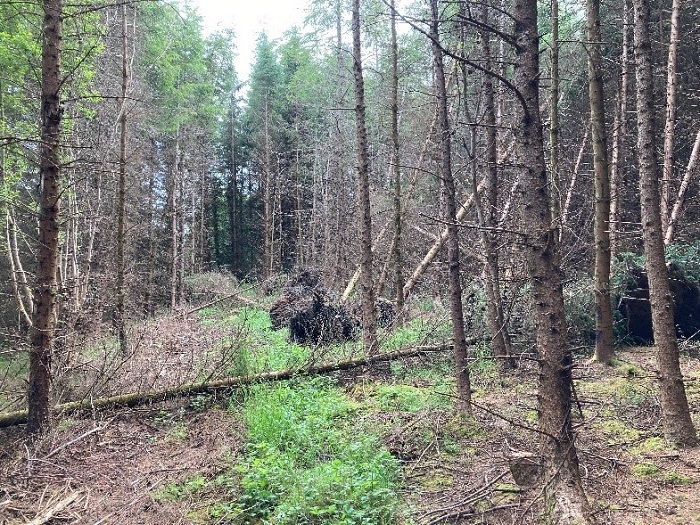31 January 2025
Safety first when dealing with storm damaged trees

With many on-farm trees blown down following Storm Éowyn, safety should remain the top priority. Teagasc Forestry Advisor, John Casey provides guidance on safety when operating a chainsaw and reminds readers of ongoing Teagasc advisory supports for farmers and forest owners.
Farmers and landowners are urged to consider the dangers associated with tree felling and cutting, and particularly the additional dangers associated with storm-damaged trees. The Teagasc National Farm Survey indicates that about 6.5% of all injuries in the Agriculture & Forestry sector are chainsaw or wood-related, indicating that approximately 120 serious injuries occur each year. Self-employed farmers, farm workers and contractors are deemed particularly at risk.
Storm-damaged forests
A storm-damaged forest can be a very hazardous place. Fallen and windblown trees are particularly risky to handle, especially near roads or power lines. Only fully trained, accredited and experienced professionals, with appropriate insurance, should undertake this work. Make safety your top priority and follow the Health & Safety Authority’s guidelines. Remember, as a forest owner, you also have legal responsibilities. Find all the necessary advice at Teagasc Forestry Safety webpage.
Training in the safe use of the chainsaw
Felling and cutting of trees on the farm, including those affected by the recent storm, should also only be undertaken by operators who completed a suitably-accredited chainsaw training course and successfully completed the assessment suitable for the chainsaw work to be done. It is essential that these courses meet the standards laid down by City & Guilds NPTC, LANTRA, or equivalent courses, which would meet such standards as laid down by QQI (Quality and Qualifications Ireland), formerly FETAC.
Chainsaw courses with various levels of training are available. For example, a basic chainsaw course covering the felling of small trees will be up to five days in duration. Shorter courses, which only cover chainsaw maintenance and cross cutting of felled timber are also available. Such short courses do not demonstrate the techniques required for felling trees safely. Therefore, you should discuss your particular training requirements with an accredited chainsaw training provider beforehand. Persons undergoing chainsaw training must be adequately supervised.
Use personal protective equipment
To protect against serious life threatening injuries, it is very important that suitable protective clothing and equipment is worn when using a chainsaw, no matter how small the job. Modern personal protective equipment (PPE) is easy to wear, long lasting and could prevent death or serious long-term injury. It is important to understand that PPE doesn’t protect you against falling trees. Chainsaw operators should refer to the manufacturer’s handbook for safety instructions and advice.
The following safety equipment should be used:
- Safety Helmet (to conform to EN 397), suitable eye protection (Visor to EN 1731 or safety glasses to EN 166) and ear defenders (EN 352), chainsaw gloves with protective pad on the back of the left hand, leg protection incorporating clogging material (EN 381-7), safety boots with steel toecaps and a good grip (EN 381/345);
- Non-snag close-fitting outer clothing;
- Chainsaw trousers (EN 381-5). No personal protective equipment can ensure 100% protection against cutting by a hand-held chainsaw;
- A first-aid kit should be readily available, including large wound dressing;
- A fully-charged mobile phone should be to hand in case of any emergency;
- EN refers to European Standards, meaning the equipment has meet specified safety requirements.
In summary, if you intend to operate a chainsaw at work, you must ensure that:
- A risk assessment on the work to be done is carried out before commencing the work;
- You are competent or alternatively have successfully completed a chainsaw training course including an assessment which are suitable to the type of chainsaw work planned;
- You wear the Personal Protective Equipment necessary for chainsaw work activities;
- Any person working for you in connection with chainsaw and tree felling work activities is also competent and wearing appropriate PPE.
Don’t compromise on these essential safety requirements. Otherwise, you may be at risk of a serious accident to yourself or others. Teagasc Forestry Staff are available to provide support and advice to forest owners affected by the recent Storm Éowyn. A series of one to one clinics are currently in progress and advisors are available for individual consultations and guidance to support planning for post-storm recovery.
